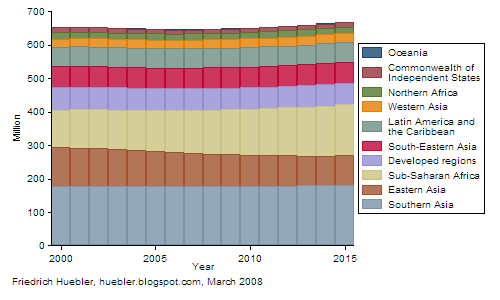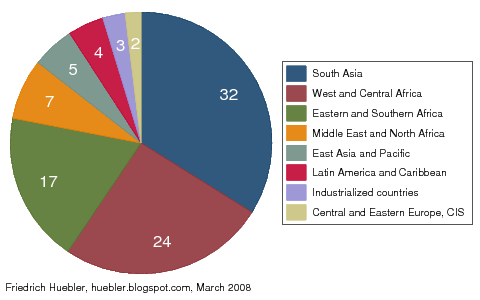The second
UN Millennium Development Goal (MDG) is the achievement of universal primary education by the year 2015. Since 2000, many countries have come closer to this goal, but at the current rate of progress it is likely that the
goal will be missed when the year 2015 arrives.
To ensure that all children attend and complete primary school, countries have to provide enough schools, teachers, and training materials. Future demographic trends are one factor that has to be taken into consideration to plan for the education system. The
UN Population Division provides population projections that can be combined with data on national primary school ages from the
UNESCO Institute for Statistics to calculate national and regional trends in the population of primary school age.
The graph and table below depict the population trends by
MDG region. At the global level, the number of children of primary school age is projected to increase from 655 million in 2000 to 668 million in 2015. In some regions, the population of primary school age is expected to shrink, while other regions experience a population increase.
Population of primary school age, 2000-2015

Data sources: (1) Population: UN Population Division, World Population Prospects 2006. (2) Primary school ages: UNESCO Institute for Statistics, Data Centre.
Two regions with very different trends stand out. In Sub-Saharan Africa, the number of children of primary school age is estimated to grow by 37 percent or 41 million children over the period 2000 to 2015. Countries in this region not only have to provide schools and teachers for all children that have been born so far, they have to increase the capacity of the education system further to accommodate the rapidly growing population. Even wealthy countries with a well-developed education infrastructure would struggle if they had to expand the capacity of their education system by more than one third over a period of 15 years.
In contrast, the population of primary school age in Eastern Asia is expected to drop by 25 percent or 29 million between 2000 and 2015, easing the pressure on the education system. Other regions with a projected decrease in the population of primary school age are the Commonwealth of Independent States and the developed countries. In Latin America and the Caribbean and in South-Eastern Asia, the population is expected to be virtually unchanged.
In Western Asia, Southern Asia, Oceania, and Northern Africa, the projections also show an increase in the population of primary school age, but at a lower relative and absolute level than Sub-Saharan Africa. Countries in the former regions therefore face fewer demographic obstacles on the path to universal primary education than countries in Sub-Saharan Africa.
Population of primary school age, 2000-2015
| Region | Population of primary school age (million) | Change 2000-2015 |
| 2000 | 2015 | Million | Percent |
| Oceania | 1.1 | 1.3 | 0.2 | 22.8 |
| Commonwealth of Independent States | 15.1 | 12.3 | -2.9 | -19.0 |
| Northern Africa | 19.7 | 20.0 | 0.3 | 1.8 |
| Western Asia | 23.9 | 27.2 | 3.2 | 13.5 |
| Latin America and the Caribbean | 58.1 | 57.7 | -0.4 | -0.7 |
| South-Eastern Asia | 63.4 | 62.9 | -0.5 | -0.8 |
| Developed countries | 67.8 | 65.0 | -2.8 | -4.2 |
| Sub-Saharan Africa | 111.4 | 152.5 | 41.1 | 36.9 |
| Eastern Asia | 117.3 | 88.2 | -29.1 | -24.8 |
| Southern Asia | 177.0 | 181.2 | 4.2 | 2.4 |
| World | 654.9 | 668.3 | 13.4 | 2.0 |
Data sources: (1) Population: UN Population Division, World Population Prospects 2006. (2) Primary school ages: UNESCO Institute for Statistics, Data Centre.
References
External links
Related articles
Friedrich Huebler, 3 March 2008 (edited 8 February 2009), Creative Commons License
Permanent URL: http://huebler.blogspot.com/2008/03/global-population-of-primary-school-age.html

